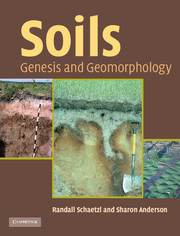Book contents
- Frontmatter
- Contents
- Preface
- Acknowledgements
- Part I The building blocks of the soil
- Part II Soil genesis: from parent material to soil
- 8 Soil parent materials
- 9 Weathering
- 10 Pedoturbation
- 11 Models and concepts of soil formation
- 12 Soil genesis and profile differentiation
- Part III Soil geomorphology
- References
- Glossary
- Index
8 - Soil parent materials
from Part II - Soil genesis: from parent material to soil
- Frontmatter
- Contents
- Preface
- Acknowledgements
- Part I The building blocks of the soil
- Part II Soil genesis: from parent material to soil
- 8 Soil parent materials
- 9 Weathering
- 10 Pedoturbation
- 11 Models and concepts of soil formation
- 12 Soil genesis and profile differentiation
- Part III Soil geomorphology
- References
- Glossary
- Index
Summary
The influence of parent materials on soil properties has long been recognized. Early pedologists and soil geographers based their concepts of soils largely on its presumed parent material. Later, parent material was viewed simply as a factor that influences soil development – an influence that diminishes in importance with time.
No one disputes the fact that geologic controls and factors are important to a complete understanding of soil development and soil patterns (Fig. 8.1). Parent material is the framework for the developing soil profile. In fact, the more holistically one examines a soil, including not just the upper 2 m or simply the solum, but also the many deep horizons, the more important parent material seems.
One goal of soil geomorphology is to identify the types and origins of a soil's parent material; any study of soil genesis must ascertain what the parent material of the soil is. Information on parent material is paramount to the study of soils, especially soils on Pleistocene or younger surfaces (Roy et al. 1967, Schaetzl et al. 2000). Many times, the role of the soil geomorphologist is to produce a surficial geology map from a soils map. From this surficial sediment map comes a better understanding of the sedimentological and surficial processes that were operative in the past. This exercise may be relatively easy for young soils on young landscapes, but it is an extreme challenge on older landscapes. Conversely, one almost cannot make a soil survey without detailed information about surficial geology, illustrating the interrelatedness of soils and parent materials in almost all landscapes.
- Type
- Chapter
- Information
- SoilsGenesis and Geomorphology, pp. 167 - 225Publisher: Cambridge University PressPrint publication year: 2005
- 1
- Cited by



